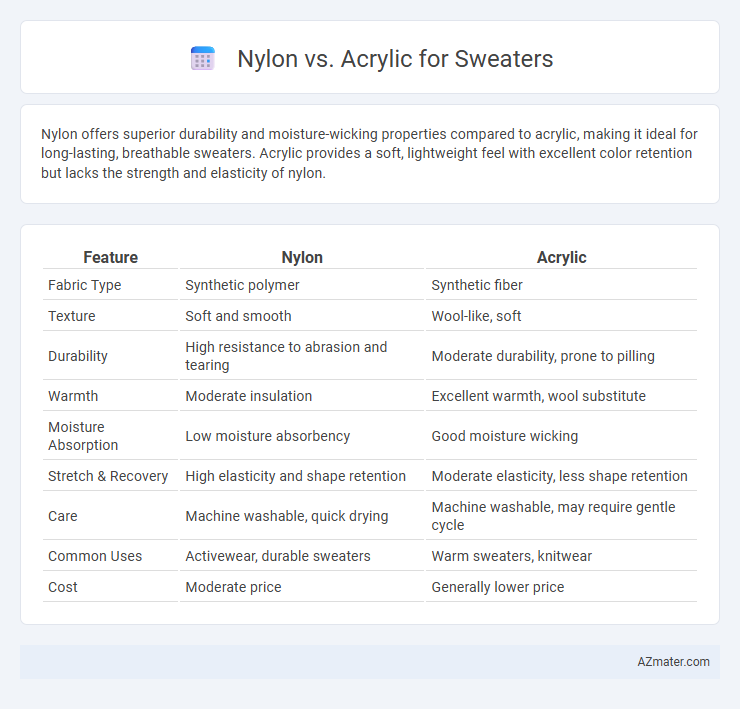Nylon offers superior durability and moisture-wicking properties compared to acrylic, making it ideal for long-lasting, breathable sweaters. Acrylic provides a soft, lightweight feel with excellent color retention but lacks the strength and elasticity of nylon.
Table of Comparison
| Feature | Nylon | Acrylic |
|---|---|---|
| Fabric Type | Synthetic polymer | Synthetic fiber |
| Texture | Soft and smooth | Wool-like, soft |
| Durability | High resistance to abrasion and tearing | Moderate durability, prone to pilling |
| Warmth | Moderate insulation | Excellent warmth, wool substitute |
| Moisture Absorption | Low moisture absorbency | Good moisture wicking |
| Stretch & Recovery | High elasticity and shape retention | Moderate elasticity, less shape retention |
| Care | Machine washable, quick drying | Machine washable, may require gentle cycle |
| Common Uses | Activewear, durable sweaters | Warm sweaters, knitwear |
| Cost | Moderate price | Generally lower price |
Introduction to Nylon and Acrylic Sweaters
Nylon and acrylic are popular synthetic fibers used in sweater manufacturing, each offering distinct benefits. Nylon provides exceptional strength, elasticity, and abrasion resistance, making it ideal for durable and form-fitting sweaters. Acrylic is valued for its softness, wool-like warmth, and moisture-wicking properties, creating cozy and lightweight garments suitable for various weather conditions.
Material Composition: Nylon vs Acrylic
Nylon, a synthetic polymer made from polyamides, offers exceptional strength, elasticity, and resistance to abrasion, making it a durable option for sweater fabric. Acrylic, composed of polyacrylonitrile, mimics wool with its soft, lightweight, and warm properties, but tends to pill and is less resilient than nylon. Comparing material composition, nylon provides superior durability and moisture-wicking, while acrylic emphasizes softness and insulation.
Warmth and Insulation Comparison
Nylon offers moderate warmth and excellent moisture-wicking properties, enhancing comfort in sweaters by keeping the wearer dry. Acrylic fibers provide superior insulation due to their ability to trap heat effectively, making them warmer in colder conditions compared to nylon. Sweaters made from acrylic blends typically retain heat better, while nylon blends improve durability and breathability without sacrificing moderate thermal protection.
Durability and Longevity
Nylon fibers exhibit superior durability and longevity compared to acrylic, maintaining structure and resistance to wear over multiple washes and extended use. Acrylic, while affordable and soft, tends to pill and degrade faster under friction and frequent laundering. Choosing nylon-enhanced sweaters ensures prolonged fabric integrity and sustained appearance, crucial for long-term wardrobe investment.
Comfort and Feel Against Skin
Nylon offers a smooth, silky texture that feels soft and lightweight against the skin, making it ideal for sensitive or allergy-prone individuals. Acrylic mimics wool's warmth but can sometimes feel slightly coarse or less breathable, which might cause discomfort during prolonged wear. Choosing nylon for sweaters ensures a more comfortable, itch-free experience, especially in close-fitting garments.
Moisture Wicking and Breathability
Nylon offers excellent moisture-wicking properties, efficiently drawing sweat away from the skin to keep the wearer dry during physical activity. Its synthetic fibers also allow for good breathability, making it suitable for sweaters designed to manage heat and moisture. In contrast, acrylic tends to trap moisture and provides less breathability, which can result in discomfort and a clammy feel in sweaters worn during active or warm conditions.
Ease of Care and Maintenance
Nylon sweaters offer superior ease of care due to their resistance to wrinkles, shrinking, and stretching, making them machine washable and quick-drying. Acrylic sweaters require gentle washing and low heat drying to prevent fibers from damage and pilling, often needing hand wash or delicate cycle care. Overall, nylon fibers provide greater durability and low-maintenance upkeep compared to acrylic's sensitivity to heat and friction.
Environmental Impact and Sustainability
Nylon and acrylic differ significantly in environmental impact and sustainability, with nylon being a synthetic polymer derived from petrochemicals that is non-biodegradable and contributes to microplastic pollution. Acrylic, also petroleum-based, shares similar sustainability challenges, often requiring substantial energy and water during production while releasing harmful emissions. Choosing sweaters made from recycled nylon or acrylic can reduce environmental harm, as these materials support circular fashion initiatives and lower overall carbon footprints.
Price Comparison and Value
Nylon sweaters typically offer greater durability and moisture-wicking properties, often justifying a slightly higher price point compared to acrylic counterparts. Acrylic sweaters tend to be more affordable, providing a budget-friendly option with good color retention and softness but may wear out faster over time. Considering long-term value, investing in nylon sweaters can result in better cost-effectiveness due to their enhanced strength and longevity.
Choosing the Best: Nylon or Acrylic Sweater
Nylon sweaters offer superior durability, elasticity, and moisture-wicking properties, making them ideal for active wear and long-lasting comfort. Acrylic sweaters provide excellent warmth, softness, and affordability, often mimicking the feel of wool without the allergenic effects. Choosing between nylon and acrylic depends on prioritizing durability and breathability versus warmth and cost-effectiveness in your sweater selection.

Infographic: Nylon vs Acrylic for Sweater
 azmater.com
azmater.com